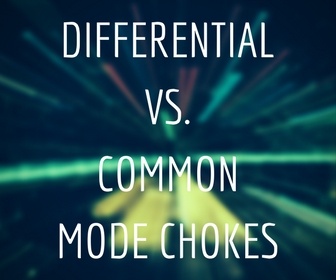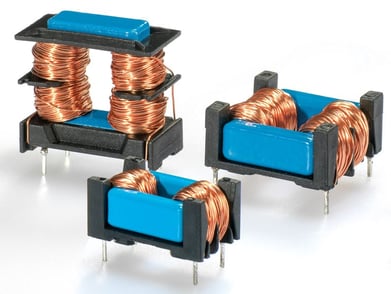Noise and other electromagnetic interference (EMI) can pass through electronic equipment as a result of coupling, conductively, via the equipment wires. When this noise occurs on a single line, it adds to the carried signal and is referred to as differential mode noise.
In an electrical circuit, a choke is used to eliminate differential mode noise, blocking the high-frequency alternating current (AC) noise while letting the direct current (DC) or lower frequency AC pass.

Chokes can be designed to block audio noise or radio noise, depending on the frequency of the interference.
To remove the extraneous signal from the cable, they use an inductor, consisting of wire wound into a coil around a core.
When unwanted signals occur on a pair of conductors, however, it is referred to as common mode (CM) noise and adds to both lines in the same direction. This can happen in equipment power cables, where the CM noise adds to the signal and neutral lines, or on the supply and return of any two wires that connect to equipment, such as an RS232 signal cable.
Common mode chokes, or common mode inductors, consist of two or more coils of insulated wire on a single magnetic core. Each winding is put in series with one of the conductors. This means that the magnetic fields of the wires combine to present high impedance to the noise signal. The desired signal can pass through the coil easily, but the noise component is attenuated, or completely blocked, by the resulting high reactance of the inductor. Overall, the choke has a low electrical resistance, allowing for minimal power loss in the process.
Since the desired currents should be equal in each coil, but the currents are flowing in opposite directions (current flowing in on one conductor, current flowing out on the other conductor), these desired currents cancel their magnetic field within the inductor core. This cancellation effect allows the core to have a relatively very high inductance to maximize the attenuation of the noise signal.
Common mode inductors are only effective when the desired currents are equal and opposite on two separate conductors, and their reactance is only effective to the noise signal. Filtering of noise from a single conductor requires a differential mode inductor.
Application of Common Mode Inductors
Common mode chokes or inductors are used in many industrial, electronics, and telecommunications applications to remove or suppress noise and other EMI on power supply cables and signal lines.
Frequently used in light-emitting diode (LED) lighting, electronics ballast, and switch-mode power supplies, common mode choke inductors filter and smooth the output, attenuating noise that would get back
onto the power line. These chokes also allow for easy equipment compliance with Federal Communications Commission (FCC) standards and other regulations.
To reliably protect electronic equipment from malfunction, optimal common mode inductor quality, durability, and reliability are critical. Whether being used to prevent unwanted noise or protect against the disruption of vital information conveyance, common mode chokes are often essential components in medical equipment, train signaling systems, and any application where interference is a major concern.
Application of Differential Mode Inductors
Differential mode inductors are used to reduce the amount of relatively high frequency AC currents in circuits with low frequency AC or DC currents. They can be used individually or grouped together with multiple inductors spaced across different locations (most commonly in the power out line and also in the power return line of power supplies).
The drawback to differential mode inductors is that they must be designed to work well (not saturate) with the full-rated desired output current while still having enough inductance to sufficiently reduce the noise signal. The size if the inductor is proportional to:
L * I^2
A differential inductor that has a comparatively high inductance and must work with a large desired current can be tens or hundreds of times larger than a unit of smaller inductance or current rating.
Triad’s CMF Series Dual Mode Common Mode Chokes

Triad Magnetics engineers and manufactures long-lasting, high-quality magnetics solutions for a wide range of industries, from medical and industrial to renewable energy and power conversion.
Although we currently offer more than a thousand standard products, we are continually developing new products to meet our customers’ ever-changing needs, including our newest offering, the CMF Series Common Mode Inductors.
Triad’s CMF Series Common Mode Inductor chokes are actually dual mode components, since they are effective in suppressing both common noise and differential noise.
Conveniently combining both functions into one compact unit, our common mode chokes are available in either a vertical or horizontal configuration; this versatility is especially useful when space must be considered in the design.
With a rated voltage of 300V AC and inductances (L) ranging from 10mH to 100mH, our custom dual mode common mode chokes are available in current ratings from 0.45A to 2.3A, all with low DC resistance. Each unit can operate within the wide temperature range of -40 to 105 °C.
Whether you select from our standard offerings of reliable common mode inductors or order a custom design or a design based on original equipment manufacturer (OEM) requirements, Triad’s strict quality standards ensure that you’ll receive only the most reliable, long-lasting noise suppression components.

To learn more about our CMF Series Common Mode Inductors or discuss how they can help with your specific application needs, contact the team at Triad today.





